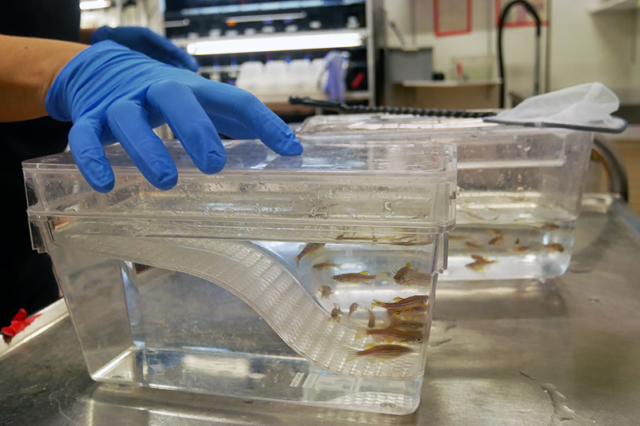Irinka Castanon is Maître Assistante in the laboratory of Marcos Gonzalez-Gaitan, Department of Biochemistry, University of Geneva. She is currently working on how membrane lipids can regulate developmental processes using the zebrafish embryo as a model system. She focuses in the role of sphingolipids in regulating oriented divisions of zebrafish ectodermal progenitor cells by controlling the palmitoylation state of the transmembrane Anthrax toxin receptor. She performs gene editing in zebrafish embryos using CRISPR/Cas 9 to support efficient functional analysis of genetic variants.
How do you apply CRISPR/Cas9 in your research?
I am using the CRISPR/Cas9 technology to induce targeted genetic modifications in genes with possible roles during zebrafish (Danio rerio) embryonic development. I am particularly interested in understanding the role of two proteins:
- the Anthrax Toxin Receptor (Antxr2a), a transmembrane protein that we found to play a role in regulating the actin cytoskeleton to ensure oriented divisions of ectodermal progenitors in zebrafish embryos
- the Serine Palmitoyltransferase (Sptlc1). Sptlc1 regulates the de novo production of sphingolipids. These type of membrane lipids are also required for proper divisions of ectodermal progenitors by regulating the lipid modification and therefore the activity of Antxr2a.
To study the function of these proteins we have generated knock outs for these two genes with a very high efficiently using the CRISPR/Cas9 technology to induce mutations through DNA double-strand breaks and error-prone repair by non-homologous end joining. Indeed, the CRISPR/Cas9 system is very efficient at generating mutations in zebrafish and it is now implemented in most laboratories using zebrafish as a model system for embryonic development, human diseases, regeneration and so on.
We are also using this technology to knock-in genetic elements to have in frame insertions. The goal is to fuse a tag (e.g. GFP) to the open reading frame of our gene of interest or to precisely introduce a desired mutation. This can be achieved by generating a break in the DNA and insert a donor DNA flanked by homologous sequences to both sides of the break by homologous recombination.
Using this approach, we are generating Antxr2a-GFP knock-in fish. This will allow us to follow the cellular distribution of the endogenous Antxr2a protein in vivo during embryonic development.
Which advantages brought the CRISPR/Cas9 to you?
Initially, genetic analysis of zebrafish development was done with mutants that were generated and identified in forward genetic screens. However, this resource was somehow limited. The introduction of morpholinos as antisense oligos to transiently knock down gene function was a great improvement for genetic analysis. They are easy to design and fast to use, but they can lead to artifacts and off-target effects. Therefore, morpholino analysis need to be accompanied by many controls.
The alternative to morpholinos came with the ZFNs (Zinc Finger Nucleases) and TALEN (Transcription Activator-Like Effector Nucleases), two technologies developed for gene editing, that can be challenging in terms of target design.
The CRISPR/Cas9 system offers several advantages: simple target design, efficiency and can be used to mutate several targets at the same time. For our particular use of the CRISPR/Cas9 system, we cannot do anything that we could not do before, but we can do it faster and with a higher efficiency. Therefore, because of all this, studies in zebrafish done exclusively with morpholinos are no longer accepted, and they need to be back up with a CRISPR null mutant, increasing the time of the research. In any case, obtaining the same outcome using different approaches is always good for science.
Is there something you think it needs to be improved?
In the case of zebrafish, the efficiency of knock-ins is currently quite low. Recent work has been focused on defining the length of the flanking homology regions to improve the efficiency and accuracy of the homologous recombination event. An additional problem in zebrafish is the high polymorphism and repetitive sequences, making the design of the flanking regions a very time-consuming step.
What’s the impact of this technology?
In the case of zebrafish research, the CRISPR/Cas9 technology has expanded the range of applications for this model system, making it even more powerful and robust in cases such as basic developmental research, to study human pathogenesis, immunity, translational research or drug discovery.
> Recommended publication about the zebrafish genome engineering using the CRISPR/Cas9 System


Leave a comment
The editors reserve the right not to publish comments or to abridge them.